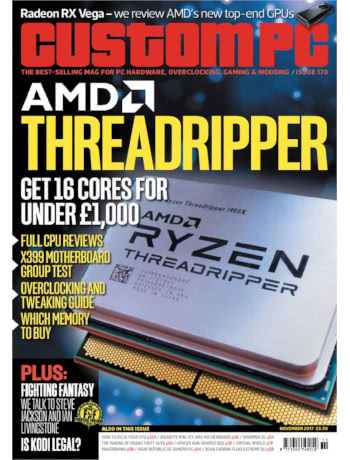
The pages of my Hobby Tech column are no stranger to Arduino-compatible handheld consoles: over the years I’ve reviewed the Gamebuino and its MAKERbuino spin-off, the Creoqode 2048, the Arduboy – then all four at once in a head-to-head group test – and most recently the Gamebuino Meta. Of these, the Arduboy was the smallest with a footprint matching a credit card and a thickness of around three cards stacked.
The PocketStar, a crowdfunded creation from Zepsch, has it beaten. Although thicker than the Arduboy, the Game Boy-inspired design has a tiny 50x30mm footprint, despite packing a colour screen and haptic feedback motor. What it doesn’t include, sadly, is a speaker – though it was originally planned, and the mounting point is still present – but it at least includes the ability to switch between games on the fly, something the Arduboy sadly lacks.
The Pimoroni Keybow, by contrast, is a very different beast. A no-solder DIY kit, the Keybow is a nine-button programmable keypad with a difference: rather than using a Teensy, Arduino, or other microcontroller, it uses a Raspberry Pi Zero WH. The reason why isn’t really adequately explained in the product briefing: it connects to the host machine via USB rather than Bluetooth, and makes no use of the Zero WH’s Wi-Fi connectivity either – though third-party firmware is available to vastly expand its functionality. Despite some bugs in the official firmware and the aforementioned surprising lack of wireless connectivity – switching to the Zero H, which does not include a radio, would shave a fiver off the retail price – it’s certainly an interesting desk accessory with plenty of flexibility.
The CRPG Book, published by Bitmap Books, doesn’t have author Felipe Pepe’s name on the cover. There’s a reason for that: it’s a collaborative effort, the physical incarnation of a four-year effort from 119 authors to document the computer role-playing game genre in as much detail as possible – going all the way back to the PLATO system and its infamous ‘friendly orange glow.’ The result is an exhaustive tome, brought to life with full-colour printing between its hardback covers – though the review is based on a digital copy, the physical version having been rejected by Bitmap Books’ quality control post-printing and sent back to the factory for a re-do with the first of the reprints due to land towards the end of the month.
While The CRPG Book is far from perfect – there are a few issues with typography and grammar, increasing in frequency as you work your way towards the back of the book – it’s pretty close to it, and made even more pleasing by the fact that the £29.99 print edition is joined by a free, Creative Commons-licensed download available from the official website. Sales of the print edition, meanwhile, have raised £12,475 in author royalties for Felipe Pepe – royalties which he has donated in full to Vocação, a not-for-profit Brazilian organisation aimed at getting children and teenagers in poor communities access to quality education.
Custom PC Magazine Issue 192 is available now at all good newsagents, supermarkets, and via the Raspberry Pi Press store. Digital outlets will update later today.



 This month’s Custom PC magazine has a bumper crop for fans of Hobby Tech: a four-page shoot-out of do-it-yourself handheld games consoles on top of my usual five-page column, which this time around looks at setting up
This month’s Custom PC magazine has a bumper crop for fans of Hobby Tech: a four-page shoot-out of do-it-yourself handheld games consoles on top of my usual five-page column, which this time around looks at setting up  This month’s Hobby Tech column has a particular focus on do-it-yourself handheld gaming, looking at two Arduino-compatible yet totally different kits: the
This month’s Hobby Tech column has a particular focus on do-it-yourself handheld gaming, looking at two Arduino-compatible yet totally different kits: the